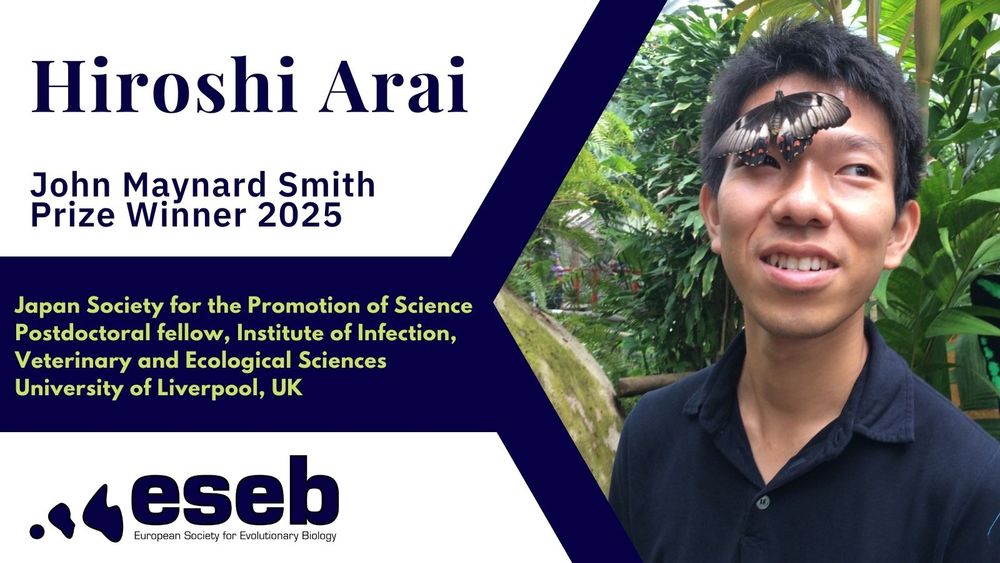
The next deadline for the #GodfreyHewitt mobility award is 31st January 2026. Open to ECRS in support of research trips or lab visits.
For more information, eligibility and how to apply: eseb.org/prizes-fundi...

The next deadline for the #GodfreyHewitt mobility award is 31st January 2026. Open to ECRS in support of research trips or lab visits.
For more information, eligibility and how to apply: eseb.org/prizes-fundi...

theconversation.com/we-created-a...

theconversation.com/we-created-a...
academic.oup.com/isd/article/...

academic.oup.com/isd/article/...
www.cell.com/cell-reports...
www.cell.com/cell-reports...
www.cell.com/cell-reports...

www.cell.com/cell-reports...
Proud to be part of this global team effort: doi.org/10.1126/scie...

Proud to be part of this global team effort: doi.org/10.1126/scie...
We ran a huge experiment to find out how ecological context favours camouflage and warning colouration as antipredator strategies. 1/6
www.science.org/doi/10.1126/...

We ran a huge experiment to find out how ecological context favours camouflage and warning colouration as antipredator strategies. 1/6
www.science.org/doi/10.1126/...
@kayla-king.bsky.social and I just wrote a Primer for @currentbiology.bsky.social on the ecology and evolution of virulence!
Check it below and share :)
#MicroSky #EvoSky #pathogens

@kayla-king.bsky.social and I just wrote a Primer for @currentbiology.bsky.social on the ecology and evolution of virulence!
Check it below and share :)
#MicroSky #EvoSky #pathogens

We summarise the current knowledge on the diversity of male-killing microbes and their mechanisms.
Available here:
🔗 www.sciencedirect.com/science/arti...

We summarise the current knowledge on the diversity of male-killing microbes and their mechanisms.
Available here:
🔗 www.sciencedirect.com/science/arti...
with @reef-combo.bsky.social and @anariesgo.bsky.social et al., and led by Hector Torrado.
Get it: authors.elsevier.com/c/1lbs~_LsQS...

with @reef-combo.bsky.social and @anariesgo.bsky.social et al., and led by Hector Torrado.
Get it: authors.elsevier.com/c/1lbs~_LsQS...
Our review paper on the striking diversity of male-killing (MK) symbionts and mechanisms has just been accepted in Trends in Genetics! I’m grateful to the reviewers for their thoughtful and valuable suggestions, and I look forward to sharing the article once it’s published
Our review paper on the striking diversity of male-killing (MK) symbionts and mechanisms has just been accepted in Trends in Genetics! I’m grateful to the reviewers for their thoughtful and valuable suggestions, and I look forward to sharing the article once it’s published
@livuni-livsrf.bsky.social @livuniresearch.bsky.social @zeiss-microscopy.bsky.social



Her research was highly commended by the Prize Committee and you can read more about her work here:
eseb.org/prizes-fundi...

Her research was highly commended by the Prize Committee and you can read more about her work here:
eseb.org/prizes-fundi...
Hiroshi will give the JMS Prize Lecture in Barcelona this August at #ESEB2025 @eseb2025.bsky.social
Read more about his prize-winning research here: eseb.org/prizes-fundi...

Hiroshi will give the JMS Prize Lecture in Barcelona this August at #ESEB2025 @eseb2025.bsky.social
Read more about his prize-winning research here: eseb.org/prizes-fundi...



